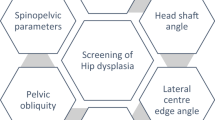Abstract
Background
Ultrasound (US) is routinely used for hip screening in children with developmental hip disorders, whereas standard hip surveillance in children with cerebral palsy is based on repeated X-ray assessments.
Objective
To evaluate US as a diagnostic tool in screening for decentered hips in children with cerebral palsy.
Materials and methods
We conducted a prospective, diagnostic single-center assessor-blind study that included consecutive children (age 2–8 years) with cerebral palsy and severe motor disability who underwent US and X-ray hip assessment. US lateral longitudinal scans were used to determine lateral head distance. X-ray assessment was used to determine migration percentage. Diagnostic properties of lateral head distance in detecting hips with a migration percentage ≥0.33 (which requires preventive treatment) were evaluated overall (n = 100) and for hips assessed at the age 24–60 months (n = 38) or >60 to ≤96 months (n = 62). Fifty hips underwent US assessment by two investigators to evaluate inter-rater reliability and agreement.
Results
Prevalence of migration percentage ≥0.33 was 22.0% overall and 26.2% and 19.4% in the younger and older age-based subsets, respectively. Lateral head distance well discriminated hips with a migration percentage ≥0.33 (areas under the receiver operating characteristics [ROC] curves 94%, 99% and 92%, respectively). At the optimum cut-off values of lateral head distance (5.0, 5.0 and 4.8 mm, respectively), sensitivity was 95.5%, 100% and 100% overall and in the two age-based subsets, respectively, whereas specificity was 85.9%, 96.4% and 72.0%, respectively. Consequently, positive predictive value was relatively low, but negative predictive value was 98.5% (95% CI 92.1–100) overall and 100% (97.5% one-sided CI 87.2–100) and 100% (97.5 one-sided CI 90.2–100) in the two age-based subsets, respectively. Inter-rater reliability was high (intraclass correlation coefficient = 0.98, 95% CI 0.97–0.99) and 95% limits of agreement were reasonably narrow (−1.203 mm to 0.995 mm).
Conclusion
In children with cerebral palsy, US can be reliably used in screening for decentered hips and can greatly reduce the need for repeated radiographic assessments, thus reducing radiation burden in these children.






Similar content being viewed by others
References
Rang M, Silver R, de la Garza J (1986) Cerebral palsy. In: Lovell WW, Winter RB (eds) Pediatric orthopedics, 2nd edn. JB Lippincott Co., Philadelphia, pp 345–396
Hodgkinson I, Jindrich ML, Duhaut P et al (2001) Hip pain in 234 non-ambulatory adolescents and young adults with cerebral palsy: a cross-sectional multicentre study. Dev Med Child Neurol 43:806–808
Knapp DR Jr (2002) Untreated hip dislocation in cerebral palsy. J Pediatr Orthop 22:668–671
Dobson F, Boyd RN, Parrott J et al (2002) Hip surveillance in children with cerebral palsy. J Bone Joint Surg (Br) 84:720–726
Hägglund G, Andersson S, Düppe H et al (2005) Prevention of dislocation of the hip in children with cerebral palsy. The first ten years of a population-based prevention programme. J Bone Joint Surg (Br) 87:95–101
Elkamil AI, Andersen GL, Hägglund G et al (2011) Prevalence of hip dislocation among children with cerebral palsy in regions with and without a surveillance programme: a cross sectional study in Sweden and Norway. BMC Musculoskelet Disord 12:284
Reimers J (1980) The stability of the hip in children: a radiological study of the results of muscle surgery in cerebral palsy. Acta Orthop Scand Suppl 184:1–100
Hilgenreiner H (1925) The early diagnosis and early treatment of congenital hip joint dislocation. Med Klin 21:1385–1388, 1425–1429
Hägglund G, Lauge-Pedersen H, Persson M (2007) Radiographic threshold values for hip screening in cerebral palsy. J Child Orthop 1:43–47
Miller F (2005) Cerebral palsy. Springer, New York
Tegnander A, Terjesen T (1999) Reliability of ultrasonography in the follow-up of hip dysplasia in children above 2 years of age. Acta Radiol 40:619–624
Palisano R, Rosenbaum P, Walter S et al (1997) Development and reliability of a system to classify gross motor function in children with cerebral palsy. Dev Med Child Neurol 39:214–223
Terjesen T, Rundén TO, Johnsen HM (1991) Ultrasound in the diagnosis of congenital dysplasia and dislocation of the hip joints in children older than two years. Clin Orthop Relat Res 262:159–169
Parrott J, Boyd RN, Dobson F et al (2002) Hip displacement in spastic cerebral palsy: repeatability of radiologic measurement. J Pediatr Orthop 22:660–667
Conflict of interest
None
Author information
Authors and Affiliations
Corresponding author
Rights and permissions
About this article
Cite this article
Šmigovec, I., Đapić, T. & Trkulja, V. Ultrasound screening for decentered hips in children with severe cerebral palsy: a preliminary evaluation. Pediatr Radiol 44, 1101–1109 (2014). https://doi.org/10.1007/s00247-014-2956-6
Received:
Revised:
Accepted:
Published:
Issue Date:
DOI: https://doi.org/10.1007/s00247-014-2956-6




